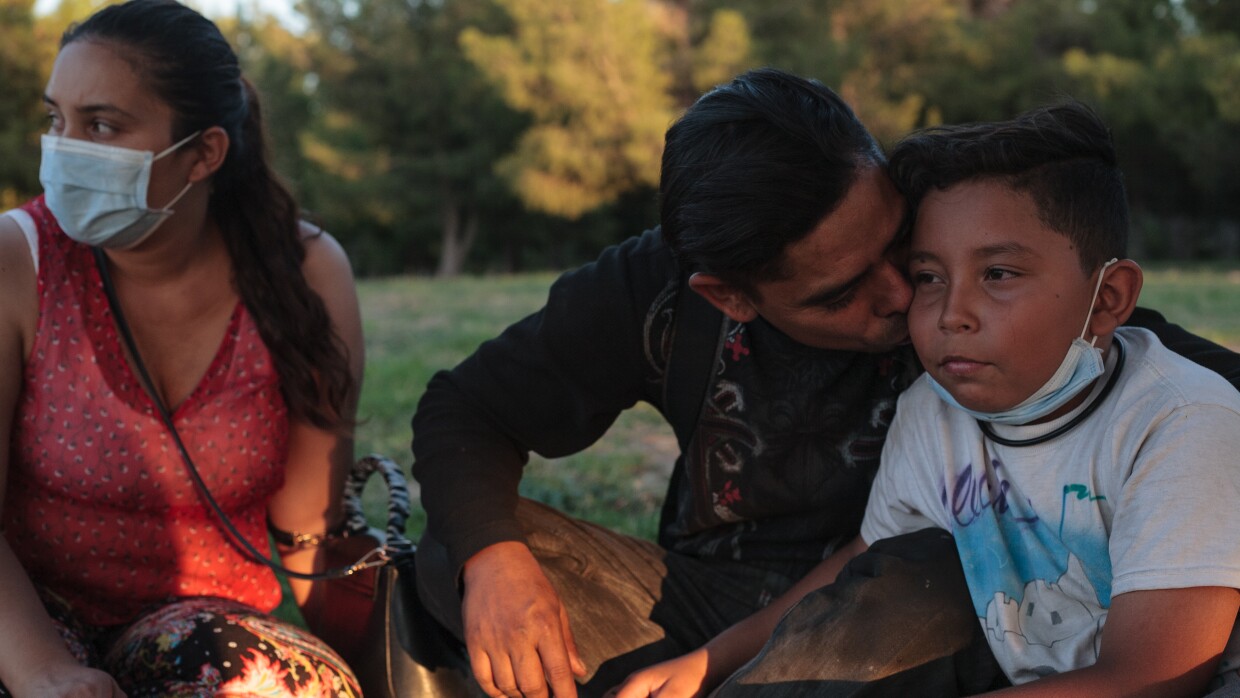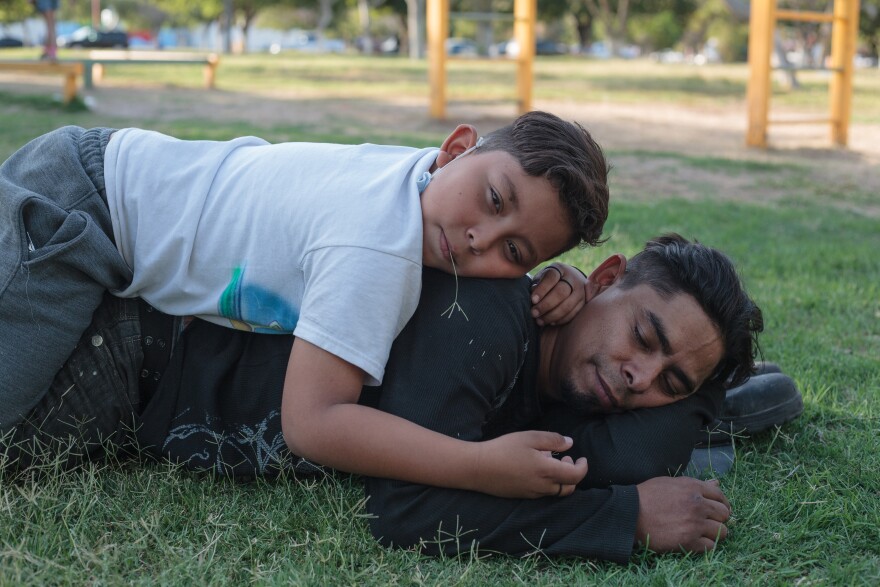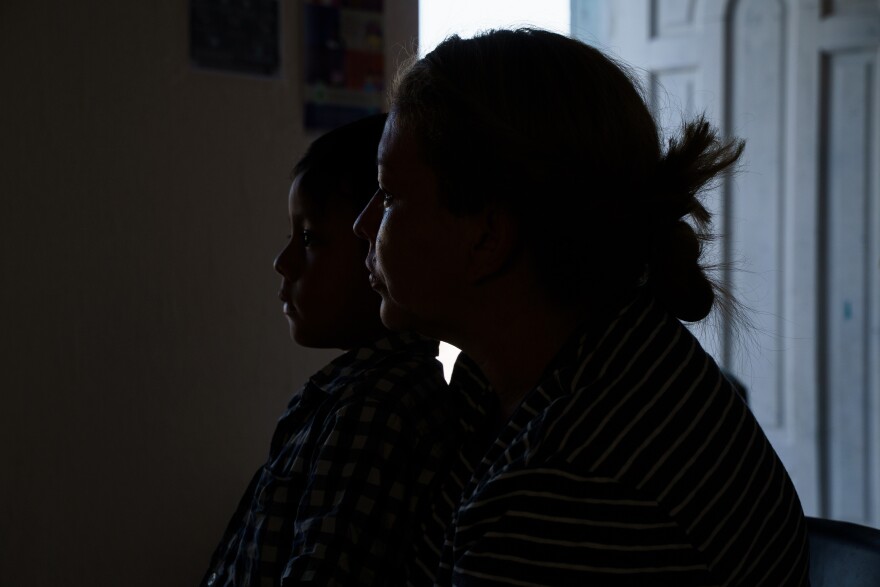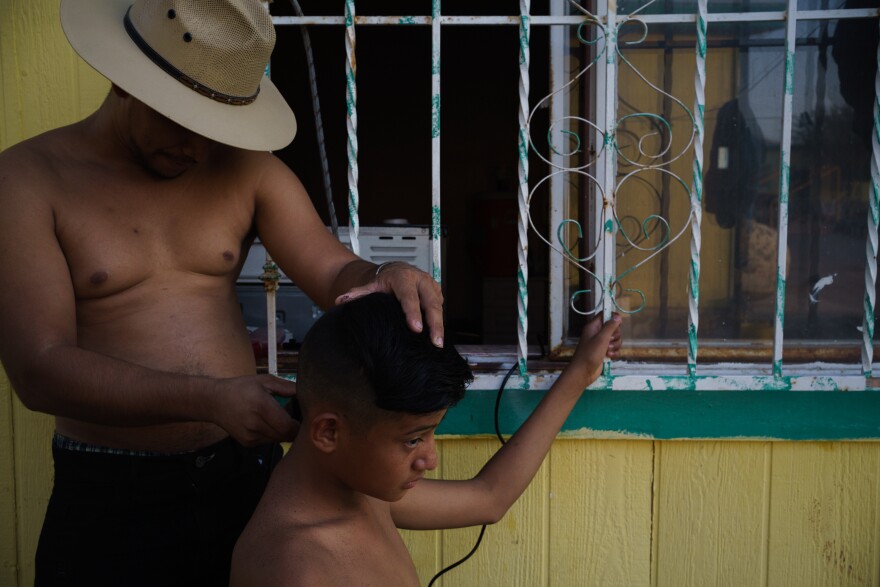The Asylum Trap: Stories From Migrants Forced To Wait In Mexico While Seeking Asylum

By Mallory Falk | KERA News
Carlo is considering sending his daughters across the U.S.-Mexico border alone, so they’re no longer “stuck in captivity.”
Levis hasn’t taken her children to play in a park for more than a year, terrified they’ll be kidnapped.
Cesar and Carolina tell their young son they’re traveling the world as tourists, but struggle to explain why they’ve spent so long in one place.
These are some of the families living in limbo in Ciudad Juárez, just across the border from El Paso. We’re not using migrants’ full names in this story because they are in the middle of immigration proceedings and fear sharing information could affect the outcome of their cases.
They were sent to wait in Mexico while their asylum cases play out in U.S. immigration court, under a Trump administration policy known as “Remain in Mexico.” Then the coronavirus pandemic struck, and their court dates were postponed again and again.
Now, these families are focused on a different date: Nov. 3. They hope a new administration might end the policy and allow them to enter the U.S., where they can wait for their day in court with family or friends. They’re not letting themselves think about what they’ll do if President Trump is reelected.
“We still have to hold on to some hope of crossing the border,” Cesar said.
'They Returned Us To A Country We Don’t Know'
The Trump administration launched Remain in Mexico — officially called the Migrant Protection Protocols, or MPP — in January, 2019. At the time, the Department of Homeland Security said the new policy would “provide a safer and more orderly process that will discourage individuals from attempting illegal entry and making false claims to stay in the U.S.”
Since then, the federal government has sent more than 60,000 asylum seekers to wait out their legal proceedings in border cities like Juárez.
Mark Morgan, acting commissioner of U.S. Customs and Border Protection, has called the policy a game changer.
“We have essentially ended catch and release,” he said at a press briefing last October. “If you come to our borders now with a child, it’s no longer an immediate passport into the interior of the United States.”
Cesar, who fled from Nicaragua with his wife and then-8-year-old son, Donovan, said the policy’s name is deceptive.
“I don’t understand this ‘migrant protection,’” he said one sweltering afternoon, sitting next to Carolina on their bed at the Pan de Vida migrant shelter. “What is the protection we have? They send you onto the street as if you were trash, an empty milk carton. Even children, they throw out children with their mothers.”

The family left their home in Jalapa, near the border with Honduras, in June 2019. Cesar worked as a taxi driver, a job that eventually put him at risk. When President Daniel Ortega proposed cutting social security, taxi drivers helped lead popular protests against the government. Security forces responded with a violent crackdown, killing more than 300 people.
Cesar said he was physically attacked by paramilitaries twice while driving his taxi, once with wife and son in the car. When they started circling his house, attempting to break in, he decided it was time to leave.
Many Nicaraguans have fled to Costa Rica, but Cesar and Carolina believed the U.S. could offer political asylum. The Trump administration has condemned Ortega’s regime for its violent repression of political opposition.
Cesar said he and his wife felt immediate relief when they reached the U.S.-Mexico border, after weeks of travel.
“We saw the officers in green and we felt protected,” Cesar recalled, referring to border patrol agents. “For the first time since these problems started, we felt protected.”
But the relief was short-lived. The family passed an initial screening, to determine whether they had a credible fear of being harmed in Nicaragua. They received paperwork with their first hearing date. But then, they were sent back across the border to Juárez.
“They returned us to a country we don’t know,” Cesar said.
A place where they didn’t have any family — unlike in the U.S., where a cousin had offered to help them get settled while they went through their asylum proceedings — and where legal help was hard to come by. A place where they felt like targets.
“For people like us, migrants, it’s a risk because people from here immediately identify the people who aren’t from here,” Carolina said. “Because of our accent. Because of the way we walk.”
A report from Human Rights First found more than 1,000 publicly reported cases of violence against migrants in MPP as of May, including kidnapping, torture, rape and murder.
Cesar and Carolina’s son Donovan is a cheerful kid with dimpled cheeks. His parents try their best to shield him from the full reality of their situation.
“We never instill anything negative in him,” Cesar said. “We tell him that we’re traveling around like tourists, getting to know new people and places.

But then Donovan asks why they’re spending so long in Juárez, instead of leaving to see other sights. Cesar simply tells him it takes time.
Cesar tries not to show his son how terrified he is, and how trapped he feels.
“If I go back to my country, they will kill me,” Cesar said. “If I’m in Mexico, I run the risk that they kidnap my child. I run the risk that they kidnap my wife.”
Throughout the Pan de Vida shelter, where around 140 migrants live, parents struggle to explain the situation to their children.
“My son asks, ‘why are we here? Why can’t we go home?’” said Cinthia, an asylum seeker from Honduras who has been at the shelter for more than a year with her 6-year-old.
“I show him videos of the U.S., to get him excited about being there,” she said.
She doesn’t tell him why they left their country. About the gang that, she said, killed two of her siblings and then came after her. She doesn’t want to scare him.
And she can’t tell him when they might be able to enter the U.S., now that asylum hearings have been postponed indefinitely.
'Stuck In Legal Purgatory'
On a chilly morning in March, Cinthia bundled up her son and traveled to a bridge between Juárez and El Paso, ready to appear in immigration court — but, she learned, hearings had been cancelled.
Crestfallen, Cinthia joined a long line of asylum seekers waiting to talk to U.S. officials and receive a new court date.
Her son noticed people breezing by them, freely crossing the bridge, and asked where they were going.
“To the U.S.,” Cinthia recalled telling him.
“Why can’t we cross like that?” he asked.
She explained that they have to wait for permission from the U.S.
“Like right now we’re getting permission from Mexico to be here,” she told him. “We need permission to be here, or otherwise they’d send us back to Honduras. Now we have to wait for permission to be in the U.S.”

That March hearing was supposed to move them closer, but it was rescheduled for August.
Then August came, and she received a new date: Feb. 3, 2021.
Cinthia’s hearing — just one of several steps in the asylum process — has now been delayed by almost a year.
“There are several people who’ve had their courts rescheduled three to four times up until now,” said Taylor Levy, an immigration attorney based in El Paso.
For months, Levy spent her mornings at the base of the Paso del Norte international bridge. When asylum seekers showed up for court, she gently broke the news that hearings were postponed. This is not an official part of her job; she just felt someone should be there, to tell people what was going on before they received new court dates from immigration officials.
These interactions often took place while it was still dark; migrants with 9 a.m. court hearings were instructed to arrive at the bridge by 4:30 a.m.. The conversations could be heartbreaking, Levy said, especially with families who came for their final hearings, thinking it was their last day in Mexico.
She remembers one little boy, about 8 years old, who showed up in a full suit, lugging a big suitcase behind him.
“I had to break it to his mom, who just burst into tears hearing that there wasn’t going to be court, that it wasn’t their final date,” she said.
These postponements would have been devastating no matter what, Levy said, but the federal government could have paroled asylum seekers into the U.S. when COVID struck, so they could shelter with relatives or other sponsors while they waited for court to reopen. Instead, they’re stuck for even longer in dangerous conditions.
In July, the federal government laid out its plans for resuming MPP hearings, including the criteria states on both sides of the U.S.-Mexico border have to meet for court proceedings to be considered safe. Mexican border states like Chihuahua must achieve “yellow” status, while states like Texas must reach Phase 3 of their reopening plans.
“There’s so many people right now who are just stuck in complete purgatory,” said Will Rocci, co-founder of Seguimos Adelante, one of the few nonprofits still providing direct, on-the-ground support to asylum seekers in Juárez during the pandemic. “They’re stuck in spatial purgatory and they’re stuck in legal purgatory. They’re not in the place they want to be, but they can’t go back to where they were.”
That desperation has driven some to give up on the legal process. Some have returned to their home countries. Others have attempted to cross the border again, without getting caught.

Levis, a Honduran asylum seeker whose hearing was rescheduled for April 2021, said she has considered that second option.
“I’m not going to lie,” she said. “I’ve thought about trying to cross another way.”
It’s difficult to know how many people have given up waiting in places like Juárez.
Levis’ husband and one of their daughters are already in the U.S.; they fled Honduras first, and arrived before the Trump administration implemented MPP.
Now, the family is separated by a thin slice of the Rio Grande and one of the Trump administration’s signature immigration policies.
Levis has been staying at the Pan de Vida shelter for more than a year with her three other children, who range in age from 5 to 14.
“All of us here despair,” she said. “Imagine being shut in for a year in this place without being able to leave,” for fear of being kidnapped or killed.
“We’re living as prisoners in this place,” she continued. “It’s been a year since my kids have been able to go out somewhere — to a park, to have fun, to be happy again. It’s not life, what we have here.”
But Levis said she has to weigh different risks. She knows crossing the desert is dangerous; her little boy and two daughters might not make it through alive.
She became emotional as she spoke, wiping tears from her face. Her son, who had been playing outside, came in to cool off and climbed up into her lap. He wrapped a small arm around her neck and pressed his cheek against hers.
For now, Levis said, she is choosing to wait here, and trying to create small moments of joy for her children when she can.
'The Last Thing You Think Of To Try'
While some parents contemplate trying to cross the border undetected — traveling through remote, desert terrain or scaling the border wall — others have started to consider another, once unthinkable option: sending their children across the border alone.
“Because of the situation here in Mexico, seeing them suffering and suffering, that crazy idea goes through my head,” Carlo said. He’s from Brazil and has been living at
El Buen Samaritano shelter in Juárez with his two children since February.
“It’s just a lot of suffering for them, being stuck in captivity day and night, day and night. It’s the last thing you think of to try.”

Carlo said his daughters are sweet girls but are struggling to adapt. Especially his youngest, a 5-year-old with soft brown curls that hang down her back.
“She’s acting more like a baby now,” he said. “She’s gone back to wetting the bed and cries over everything. I think these behaviors — wetting the bed, having nightmares, waking up in the middle of the night crying — I think it’s all part of what we’re having to go through.”
Brazilians were originally exempt from MPP; only migrants from Spanish-speaking countries were placed in the program. But just a few weeks before Carlo left, the Trump administration expanded the policy to include Brazilians. Regardless of where they crossed the border, they were all sent to Juárez.
Now, Carlo’s daughters constantly ask when they’ll get to leave the shelter and see their mother, who is already in the U.S. They’re full of questions about the city where she lives. Does it snow there? Are there beaches?
Carlo said he reached his breaking point in September, when he learned that his hearing had been rescheduled for a third time.
“I fell apart,” he said. “I thought that if I went to that hearing, I would be able to cross.”
In that moment, he started to think about sending his daughters across the border without him. It would be a last resort, he stressed, born of desperation.
Other families have already done this. In January, even before the pandemic struck, CNN found that at least 350 children had crossed the border by themselves after living in Mexico.
Before COVID-19, unaccompanied children received special protections. The U.S. government could not immediately deport them or send them back into Mexico. They were typically placed in a youth shelter, then released to relatives or sponsors in the U.S. while they pursued their asylum cases.
But during the pandemic, the U.S. government has started rapidly expelling children, putting them on planes and sending them — alone — back to their home countries.
The Trump administration says it’s trying to prevent the spread of COVID-19, and has the authority to carry out these expulsions due to a public health order issued in March.
But the AP recently reported that experts with the Centers for Disease Control and Prevention initially refused to issue the order, saying there was no evidence it would slow the coronavirus. The agency only reversed course when Vice President Mike Pence intervened.
The ACLU’s Immigrants’ Rights Project recently filed a class-action lawsuit challenging the rapid expulsion of children. As the litigation plays out, advocates on the ground are trying to warn families of the risks inherent in sending their children across the border alone.
“One of the biggest things we’re trying to get across to people, just constantly, is how incredibly dangerous it is,” said immigration attorney Taylor Levy. She explains that children may not reach the U.S. safely and even if they do, “there’s a strong possibility that your kid might be sent back to Honduras, sent back to El Salvador alone.”

But families are desperate. Levy said she has heard stories about small children trying to kill themselves, and teenagers spending weeks in bed, struggling with depression.
She has started calling MPP “Family Separation 2.0”: the government created a situation so dire, parents believe their best option is sending their children across the border without them, knowing they may never see each other again.
Levy said families have even pleaded with her to take their children across the border herself, convinced that her status — as a white, U.S.-born lawyer — will offer protection.
“People will straight up tell me, ‘you’re white; can’t you take my 5-year-old across the border? Just take them and say, please Americans, please help them. They’ll understand,’” she said. And to be begged to take someone’s child over and over and over again by so many different people has been truly shocking.”
For his part, Carlo continues to waver. Sometimes he thinks it’s worth the risk, then second guesses himself.
If he knew someone could safely deliver his daughters to their mother, he would do it. They could be with her for Christmas, and to celebrate her birthday. Two milestones he doesn’t want them to pass at the shelter.
Hanging Hope On The Election
Many families are waiting to make decisions about their next steps until after Nov. 3.
“Changing the president obviously changes policies,” said José, a former nurse who fled political persecution in Nicaragua.
When he left his country, José was on his own. But in Juárez, he met another asylum seeker: a Guatemalan woman with short hair and a sweet smile.
“We just entwined really well,” he said. “I never thought I’d meet someone who I just connected with like that.”
They constantly sent each other messages. He brought her chocolate and some of his favorite food. Eventually, they moved in together, sharing a room at a migrant shelter. They’re currently engaged and expecting a child.
But since their asylum cases are in different stages, their future is uncertain.

“A lot of people have heard that, depending on how the election turns out, potentially MPP could be ended,” said Will Rocci of Seguimos Adelante. “I think that’s the biggest hope that a lot of people are holding onto right now.”
The hope isn’t just that their hearings will start back up, but that they’ll be permitted to enter the U.S. and wait out their legal proceedings in a safer setting, with family or friends. And that they’ll stand a better chance of gaining asylum, because they’ll have better access to legal counsel — and the ability to make their cases in courtrooms where they face better odds.
El Paso immigration courts have some of the highest asylum denial rates in the country, with all but one judge denying more than 90% of cases.
“Their chances of obtaining asylum, all things equal, [would] likely improve significantly” if migrants were allowed into the country and permitted to change court venues, said Nicolas Palazzo, an attorney with Las Americas Immigrant Advocacy Center.
During his reelection campaign, President Trump has continued to propose tighter restrictions on immigration.
Meanwhile, Democratic presidential nominee Joe Biden has pledged to end MPP within his first hundred days in office.
But as for how exactly a new administration could unwind the program, “that’s the $64,000 question,” Palazzo said.
“We’re talking thousands of people," he said. "So I don’t expect the last week of January for the gates to be open and people just allowed to shuffle in.”
Sarah Pierce with the Migration Policy Institute said, “I would assume, at the very least, that the administration would consider granting parole to the individuals in MPP so they can wait for their asylum proceedings inside the United States.”
Pierce is a policy analyst at the nonpartisan thinktank. She recently helped catalogue more than 400 executive actions the Trump administration has taken on immigration, from stepping up border enforcement to slashing refugee visas.
Pierce said because MPP was handed down as a policy— “really, just a memo” — it may be easier roll back than some other changes to the asylum process.
She said a new administration could not, however, just immediately unwind everything the Trump administration has done, because of both regulatory and logistical challenges.
MPP is also being challenged in court. On Oct. 19, the Supreme Court announced it will review the policy. The Trump administration appealed a 2019 decision by a lower court that found the policy likely violated U.S. immigration law.

For now, Cesar and Carolina, the Nicaraguan couple living at Pan de Vida migrant shelter, are closely following the presidential race.
“Our hope is that there will be some change that benefits all of us here,” Carolina said.
She believes that if President Trump is reelected, there is almost no chance her family will be allowed to enter the country or gain asylum.
But she and Cesar haven’t even let themselves think about what they’ll do then. They say they have to hold on to one last shred of hope.
“There are people who come to the U.S. seeking the American dream,” Cesar said. “We didn’t flee because we wanted to. We didn’t leave behind our life in Nicaragua — leave our parents, our nieces and nephews, our friends — because we wanted to. We were forced to leave our country.”
All they’re asking, he said, is for safety. Something that feels even more critical now; a few months ago, Cesar and Carolina learned she is pregnant with their second child.
They don’t want their baby growing up in a dismal, gray atmosphere, they said. They want a bright environment for their children.
Editor’s Note: Some interviews in this story were conducted in Spanish and Portuguese, then translated to English.
Mallory Falk is a corps member with Report For America, a national service program that places journalists into local newsrooms. Got a tip? Email Mallory at Mfalk@kera.org. You can follow Mallory on Twitter @MalloryFalk.
KERA News is made possible through the generosity of our members. If you find this reporting valuable, consider making a tax-deductible gift today. Thank you.






